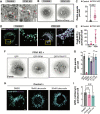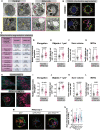This is a preprint.
The actin binding protein profilin 1 is critical for mitochondria function
- PMID: 37609280
- PMCID: PMC10441311
- DOI: 10.1101/2023.08.07.552354
The actin binding protein profilin 1 is critical for mitochondria function
Update in
-
The actin binding protein profilin 1 localizes inside mitochondria and is critical for their function.EMBO Rep. 2024 Aug;25(8):3240-3262. doi: 10.1038/s44319-024-00209-3. Epub 2024 Jul 18. EMBO Rep. 2024. PMID: 39026010 Free PMC article.
Abstract
Profilin 1 (PFN1) is an actin binding protein that is vital for the polymerization of monomeric actin into filaments. Here we screened knockout cells for novel functions of PFN1 and discovered that mitophagy, a type of selective autophagy that removes defective or damaged mitochondria from the cell, was significantly upregulated in the absence of PFN1. Despite successful autophagosome formation and fusion with the lysosome, and activation of additional mitochondrial quality control pathways, PFN1 knockout cells still accumulate damaged, dysfunctional mitochondria. Subsequent imaging and functional assays showed that loss of PFN1 significantly affects mitochondria morphology, dynamics, and respiration. Further experiments revealed that PFN1 is located to the mitochondria matrix and is likely regulating mitochondria function from within rather than through polymerizing actin at the mitochondria surface. Finally, PFN1 mutants associated with amyotrophic lateral sclerosis (ALS) fail to rescue PFN1 knockout mitochondrial phenotypes and form aggregates within mitochondria, further perturbing them. Together, these results suggest a novel function for PFN1 in regulating mitochondria and identify a potential pathogenic mechanism of ALS-linked PFN1 variants.
Conflict of interest statement
Declaration of Interests The authors declare no competing interests.
Figures






References
-
- Pollard T.D., and Borisy G.G. (2003). Cellular motility driven by assembly and disassembly of actin filaments. Cell 112, 453–465. - PubMed
Publication types
Grants and funding
LinkOut - more resources
Full Text Sources
Research Materials
Miscellaneous
